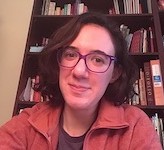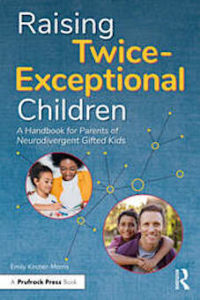Keys to Helping 2e Kids Develop Lifelong Skills
Raising Twice-Exceptional Children: A Handbook for Parents of Neurodivergent Gifted Kids
By Emily Kircher-Morris
(Routledge/Prufrock Press, 2022- Learn more)
Reviewed by Amy Estersohn
 I can imagine a parent or teacher innocently asking, “What is twice-exceptional, and how do I know if I am working with a twice-exceptional child?” without realizing that identifying a twice (or multiple) exceptional student is as much a challenge as working with that exceptional student.
I can imagine a parent or teacher innocently asking, “What is twice-exceptional, and how do I know if I am working with a twice-exceptional child?” without realizing that identifying a twice (or multiple) exceptional student is as much a challenge as working with that exceptional student.
In short, a twice-exceptional student is gifted and has one (or more) learning differences. Some examples of a twice-exceptional student could include
● A child with a high IQ and ADHD
● A quick-thinking student with exceptional verbal skills who struggles with printed reading material due to dyslexia
● A passionate and curious learner who also has autism
● A deeply creative person whose slow processing interferes with test performance

A diagnosis can be a sigh of relief to a student or parent asking, “Why me?” Finding a psychologist who is familiar with twice-exceptional children and how different exceptionalities can skew testing one way or another is key towards receiving a comprehensive diagnosis.
Emily Kircher-Morris writes this parent handbook through her role as a mental health counselor, the host of The Neurodiversity Podcast, and a self-identified neurodivergent person.
Lifelong skills beyond a diagnosis
The emphasis of this handbook is on lifelong skills for twice and multiply exceptional students. It is based on the premise that all children deserve to be treated as whole, and that their unique qualities should be affirmed and celebrated. Rather than provide an external, rewards-based system for desired behaviors, Kircher-Morris identifies key skills that twice-exceptional children often work to develop and devotes a chapter to each one.
Those skills are:
Self-Advocacy. Kircher-Morris writes, “Those around the twice-exceptional child assume that something as ‘simple’ as asking for help should be no problem for a child who can expound on the nature of the space-time continuum” (105). She uses Deb Douglas’s work to discuss how academically advanced students ask for help.
Emotional Regulation. The chapter focuses on understanding emotions and learning what a proportional reaction to the challenge or setback may be. This chapter is inspired by Dr. Michelle Borba’s writings.
Executive Functioning. Kircher-Morris advocates for a scientific method-like approach where students study their habits and begin to form hypotheses, collect data, and analyze results, like, “Will setting an alarm on my phone help me remember to bring my trumpet home from school?”
Effective Social Communication. Many twice-exceptional students find peer relationships challenging. Kircher-Morris presents pros and cons of different kinds of social experiences (e.g. online friends) and creatively brainstorms ways that twice-exceptional students can have meaningful and constructive social experiences.
Self-Directed Motivation. A values inquiry model is provided to help students identify and align their reasoning and inspiration for their behaviors.
Each of these skills is addressed through the lens of self-acceptance. Kircher encourages, “When you start working on the skills that your child needs for success, recognize each success as a step closer to your child’s goals… It is possible they may never completely ‘catch up,’ but remember that catching up isn’t necessarily the goal. The goal is to help them learn to work with their strengths and through their struggles. And every little bit of progress is worth celebrating” (89).
A parenting handbook: not a manual, textbook, or research guide
This clear, quick, and easy-to-browse volume has a parent audience in mind. (Hey, it even says so on the cover.) Graduate students, researchers, or parents who are interested in the science behind these diagnoses and interventions will find that the references to other articles and research are thin and there are no recommendations for further reading in the book.
I don’t think the busy, frantic parent is going to mind, but I can see the graduate student or independent researcher finding this book less than what they need in the way of robust scientific inquiry.
For more on twice exceptional learners, read Emily Kircher-Morris’s MiddleWeb article Help Twice-Exceptional (2e) Learners Flourish along with this review of her book Teaching Twice-Exceptional Learners in Today’s Classroom.
Amy Estersohn is a teacher and college admissions consultant who has worked with twice-exceptional students. She runs a College Spotlight newsletter and can be reached at leadwithtalents@gmail.com.





























